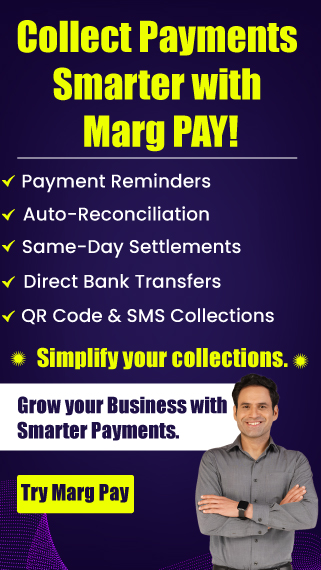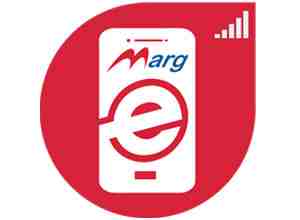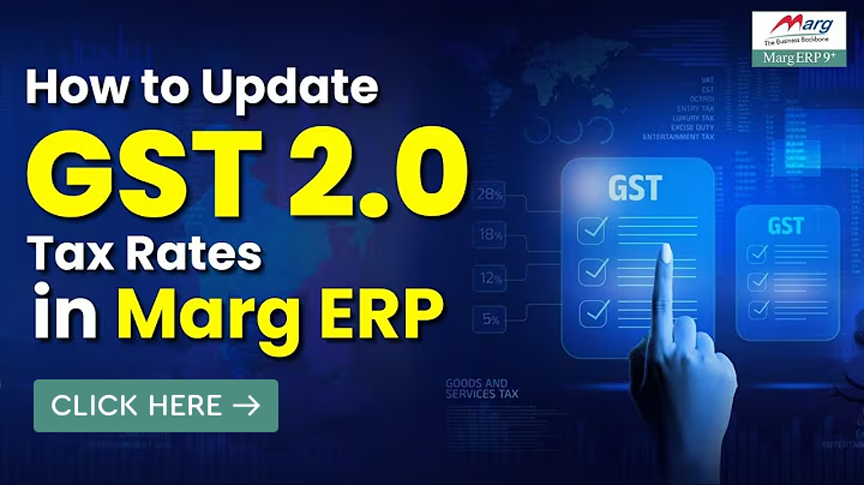Search by Category
- Marg Digital Health
- ABHA 2.0 - Ayushman Bharat
- Marg Nano
- Swiggy & Zomato
- Marg Cloud
-
Masters
- Ledger Master
- Account Groups
- Inventory Master
- Rate and Discount Master
- Refresh Balances
- Cost Centre Master
- Opening Balances
- Master Statistics
- General Reminder
- Shortage Report
- Supplier Vs Company
- Temporary Limit
- Shop QRID and eBusiness
- Cloud Backup Setup
- Password and Powers
- Marg Licensing
- Marg Setup
- Target
- Budget
- Credit Limit Management
- Change ERP Edition
- Ease Of Gst Adoption
-
Transactions
- ERP To ERP Order
- Sale
- Purchase
- Sale Return
- Purchase Return
- Brk / Exp Receive
- Scrap Receive
- Brk / Exp Issue
- Scrap Issue
- GST Inward
- GST Outward
- Replacement Issue
- Replacement Receive
- Stock Issue
- Stock Receive
- Price Diff. Sale
- Price Diff. Purchase
- BOM
- Conversion
- Quotation
- Sale Order
- Purchase Order
- Dispatch Management
- ERP Bridger
- Transaction Import
- Download From Server
- Approvals
- Pendings
- Accounts
- Online Banking
-
Books
- Cash and Bank Book
- All Ledgers
- Entry Books
- Debtors Ledgers
- Creditors Ledger
- Purchase Register
- Sale Register
- Duties & Taxes
- Analytical Summaries
- Outstandings
- Collection Reports
- Depreciation
- T-Format Printing
- Multi Printing
- Bank Reconcilation
- Cheque Management
- Claims & Incentives
- Target Analysis
- Cost Centres
- Interest and Collection
- Final Reports
-
Stocks
- Current Stock
- Stock Analysis
- Filtered Stock
- Batch Stock
- Dump Stock
- Hold/Ban Stock
- Stock Valuation
- Minimum Level Stock
- Maximum Level Stock
- Expiry Stock
- Near Expiry Stock
- Stock Life Statement
- Batch Purchase Type
- Departments Reports
- Merge Report
- Stock Ageing Analysis
- Fast and Slow Moving Items
- Crate Reports
- Size Stock
-
Daily Reports
- Daily Working
- Fast SMS/E-Mail Reports
- Stock and Sale Analysis
- Order Calling
- Business on Google Map
- Sale Report
- Purchase Report
- Inventory Reports
- ABC Analysis
- All Accounting Reports
- Purchase Planning
- Dispatch Management Reports
- SQL Query Executor
- Transaction Analysis
- Claim Statement
- Upbhogkta Report
- Mandi Report
- Audit Trail
- Re-Order Management
- Reports
-
Reports Utilities
- Delete Special Deals
- Multi Deletion
- Multi Editing
- Merge Inventory Master
- Merge Accounts Master
- Edit Stock Balance
- Edit Outstanding
- Re-Posting
- Copy
- Batch Updation
- Structure/Junk Verificarion
- Data Import/Export
- Create History
- Voucher Numbering
- Group of Accounts
- Carry Balances
- Misc. Utilities
- Advance Utilities
- Shortcut Keys
- Exit
- Generals
- Backup
- Self Format
- GST Return
- Jewellery
- eBusiness
- Control Room
- Advance Features
- Registration
- Add On Features
- Queries
- Printing
- Networking
- Operators
- Garment
- Hot Keys
-
GST
- E-Invoicing
- Internal Audit
- Search GSTIN/PARTY
- Export Invoice Print
- Tax Clubbing
- Misc. GST Reports
- GST Self-Designed Reports
- GST Return Video
- GSTR Settings
- Auditors Details
- Update GST Patch
- Misc. GST Returns
- GST Register & Return
- GST RCM Statement
- GST Advance Statement
- GST Payment Statement
- Tax Registers and Summaries
- TDS/TCS Reports
- Form Iss./Receivable
- Mandi
- My QR Code
- E-Way Bill
- Marg pay
- Saloon Setup
- Restaurant
- Pharmanxt free Drugs
- Manufacturing
- Password and Power
- Digital Entry
Home > Margerp > Sale > How to Apply RCM on Goods Transport Agency / Transporters in Marg Software ?
How to Apply RCM on Goods Transport Agency / Transporters in Marg Software ?
Overview of GTA/Transporters in Marg ERP
Process to Apply RCM to the GTA/Transporters in Marg ERP
OVERVIEW OF GTA/TRANSPORTERS IN MARG ERP
- The Goods Transport Agency is a reliable and efficient transportation service provider. The Transport Agency provides the road transport service for the companies to transfer goods from one place to another. As part of their service, Transporter/GTA issues a Consignment Note to document the transportation process.
- Under the GST Provision, the government calculates the tax at a rate of 5% from the Company instead of from the Transportation Agency through the Reverse Charge Mechanism (RCM) Method. In this case, the Company receives the Input Tax Credit (ITC) instead of the transporters.
- Marg ERP has provided a very beneficial provision in the software that when the Transporter generates the Sale Bill to provide the Transporter's services, the Transportation Tax is not calculated.
- This provision helps streamline operations for transporters & ensures a smoother taxation process for all parties involved.
PROCESS TO APPLY RCM TO THE GTA/TRANSPORTERS IN MARG ERP
- Go to Masters > Marg Setups > Control Room.
- A ‘Control Room’ window will appear.
- Click on ‘Search in All’ option.
- A ‘Controls’ window will appear.
- In ‘Search’ field, search ‘RCM’.
- Click on ‘Accept’ tab.
- A ‘RCM’ window will appear with different options.
- In ‘Reverse Charge on Sales also’ option, select ‘Yes’ from the dropdown.
- Then press ‘ESC’ key.
- Click on ‘Yes’ to save the changes.
- Now, let’s generate the Sale Type. For this go to Masters > Ledger Master > Sale > New Sale.
A ‘Sales Type’ window will appear.
a. Sales Type: The user will select the Sale Type i.e. ‘Local’ or ‘Central’ as per the requirement.
Suppose, select ‘Local’.
b. SGST: In SGST, the user will enter the tax percentage i.e. 2.5%.
c. CGST: In CGST, the user will enter the tax percentage i.e. 2.5%.
d. Shortcut Name: The Shortcut Name will be automatically picked up by the software based on Sales Type & Tax Rate.
- The user can change it as per the requirement.
Note: The user will first type ‘RCM’ and then mention the name accordingly.
e. Sale Under: Here, a window of ‘Under Sales Group’ will appear. As the user is creating the Sales Type for Local, then select ‘Local Sales’ and press 'Enter' key.
Sale Ledger Name: This will be automatically picked by the software.
SGST Under: The user will select 'Tax - SGST' for SGST posting.
SGST Ledger: The SGST Ledger will be automatically picked by the software.
CGST Under: The user will select 'Tax - CGST' for CGST posting.
CGST Ledger: This will be automatically picked by the software.
T. Form: Tthe user can select the type of form if required. Suppose in our case skip it and press 'ESC' key.
- Then click on ‘Accept’ tab.
- Go to Transactions > Sale > Bill.
- A 'Sale Entry' window will appear.
- Press the ‘F3’ key on a particular party for whom the Sale Bill needs to be generated.
- Then click on the ‘Ledger Detail’ option.
- Click the ‘Modify’ tab.
- In the ‘GST Heading’ field, select ‘Ask Local’ from the dropdown.
- This means while billing, the software will ask for the 'Local’ Sales Type.
- Press the ‘PageDown’ key and save the details.
- Now, while creating the Sale Bill, when the user will go to the ‘Type’ field and press the ‘Spacebar’ key.
- Then a ‘Sales Type’ window will appear where the software will ask Sales Type.
- Select the Sales Type that has been created, i.e., RCM LS-GST 5%.
- Then select the Item and mention the desired Qty. and Rate.
- The user can see that the software does not calculate the Tax.
- Now press 'Ctrl+W' key and click on 'Save Bill'.
- Go to GST > GSTR 1.
- A ‘Marg GST Summary’ window will appear.
- In the ‘Period’ field, mention the period for which the user needs to view the GSTR 1 Summary.
- Click on ‘Show’.
- Press ‘Enter’ key on the ‘B2B’ record.
- The user will view the created bill here and in the ‘Reverse Charge’ column, it is showing a tick mark which means that the RCM has been applied to it.
- Now the user will click on ‘GSTR 1 Returns’ to generate the GSTR 1 Return.
- A ‘GSTR 1’ window will appear. Select the format where the user needs to generate the GSTR 1.
- Suppose, select ‘GSTN Excel Template’.
- Then click on ‘Start’.
- The user can view that the GSTR1 Return will start getting generated.
- Once the GSTR 1 Return is generated, an Excel file will open.
- The user will view that in the ‘Reverse Charge’ column, it is showing as ‘Y’ for the bill that has been created, i.e., the RCM will not be applied on the Transport at the time of Billing, but at the time of GSTR 1 Return, RCM will be applicable.


 -
Marg ERP 9+
-
Marg ERP 9+











